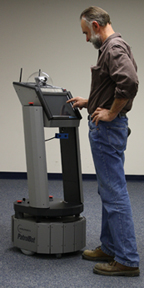Robots in society

Roughly half of all the robots in the world are in Asia, 32% in Europe, and 16% in North America, 1% in Australasia and 1% in Africa.[108] 40% of all the robots in the world are in Japan,[109] making Japan the country with the highest number of robots.
Autonomy and ethical questions

As robots have become more advanced and sophisticated, experts and academics have increasingly explored the questions of what ethics might govern robots' behavior,[111][112] and whether robots might be able to claim any kind of social, cultural, ethical or legal rights.[113] One scientific team has said that it was possible that a robot brain would exist by 2019.[114] Others predict robot intelligence breakthroughs by 2050.[115] Recent advances have made robotic behavior more sophisticated.[116] The social impact of intelligent robots is subject of a 2010 documentary film called Plug & Pray.[117]
Vernor Vinge has suggested that a moment may come when computers and robots are smarter than humans. He calls this "the Singularity".[118] He suggests that it may be somewhat or possibly very dangerous for humans.[119] This is discussed by a philosophy called Singularitarianism.
In 2009, experts attended a conference hosted by the Association for the Advancement of Artificial Intelligence (AAAI) to discuss whether computers and robots might be able to acquire any autonomy, and how much these abilities might pose a threat or hazard. They noted that some robots have acquired various forms of semi-autonomy, including being able to find power sources on their own and being able to independently choose targets to attack with weapons. They also noted that some computer viruses can evade elimination and have achieved "cockroach intelligence." They noted that self-awareness as depicted in science-fiction is probably unlikely, but that there were other potential hazards and pitfalls.[118] Various media sources and scientific groups have noted separate trends in differing areas which might together result in greater robotic functionalities and autonomy, and which pose some inherent concerns.[120][121][122]
Military robots
Some experts and academics have questioned the use of robots for military combat, especially when such robots are given some degree of autonomous functions.[123] There are also concerns about technology which might allow some armed robots to be controlled mainly by other robots.[124] The US Navy has funded a report which indicates that, as military robots become more complex, there should be greater attention to implications of their ability to make autonomous decisions.[125][126] One researcher states that autonomous robots might be more humane, as they could make decisions more effectively. However, other experts question this.[127]
One robot in particular, the EATR, has generated public concerns[128] over its fuel source, as it can continually refuel itself using organic substances.[129] Although the engine for the EATR is designed to run on biomass and vegetation[130] specifically selected by its sensors, which it can find on battlefields or other local environments, the project has stated that chicken fat can also be used.[131]
Manuel De Landa has noted that "smart missiles" and autonomous bombs equipped with artificial perception can be considered robots, as they make some of their decisions autonomously. He believes this represents an important and dangerous trend in which humans are handing over important decisions to machines.[132]
Relationship to unemployment
For centuries, people have predicted that machines would make workers obsolete and increase unemployment, although the causes of unemployment are usually thought to be due to social policy.[133][134][135]
A recent example of human replacement involves Taiwanese technology company Foxconn who, in July 2011, announced a three-year plan to replace workers with more robots. At present the company uses ten thousand robots but will increase them to a million robots over a three-year period.[136]
Lawyers have speculated that an increased prevalence of robots in the workplace could lead to the need to improve redundancy laws.[137]
Kevin J. Delaney said "Robots are taking human jobs. But Bill Gates believes that governments should tax companies' use of them, as a way to at least temporarily slow the spread of automation and to fund other types of employment."[138] The robot tax would also help pay a guaranteed living wage to the displaced workers.
The World Bank's World Development Report 2019 puts forth evidence showing that while automation displaces workers, technological innovation creates more new industries and jobs on balance.[139]
Contemporary uses

At present, there are two main types of robots, based on their use: general-purpose autonomous robots and dedicated robots.
Robots can be classified by their specificity of purpose. A robot might be designed to perform one particular task extremely well, or a range of tasks less well. All robots by their nature can be re-programmed to behave differently, but some are limited by their physical form. For example, a factory robot arm can perform jobs such as cutting, welding, gluing, or acting as a fairground ride, while a pick-and-place robot can only populate printed circuit boards.




No comments:
Post a Comment